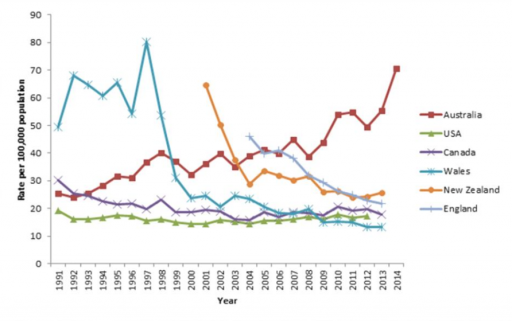Stopping Australia’s growing Salmonella poisoning problem
At the recent NSW Environmental Health conference, the Chief Executive Officer of the NSW Food Authority, Dr Lisa Szabo, had some disturbing news…
While the rest of the world appears to be getting Salmonella under control, Australia’s trend is going in the wrong direction.

Preventing Salmonella poisoning
So what can be done to reverse this trend?
Cooking food
Salmonella bacteria is found in many different places. It is present in many animals, especially chickens, and can be transmitted if the meat from infected animals is not cooked properly. The animals themselves do not appear sick, nor does the meat look or smell unusual.
Cooking meat and eggs over 70°C will destroy the bacteria.
Preventing cross contamination
In kitchens with poor food safety practices, bacteria can be passed from raw meat to ready-to-eat meals via contaminated knives, platters, chopping boards and unwashed hands.
Not using raw eggs
A significant number of Salmonella cases come from raw eggs and raw egg products. In one famous NSW case, 168 people were poisoned by a restaurant’s homemade aioli. A safer alternative is to use commercially produced sauces and dressings. If you must make your own, using pasteurised egg products rather than raw eggs is much safer. Or if you must use raw eggs, make sure the temperature is kept below 5° and add vinegar or lemon juice to make the food too acidic for bacterial growth.
Wash fresh fruit and vegetables
A recent major outbreak of Salmonellosis was attributed to rockmelons. There were 86 cases reported across Australia. Is was thought that washing the rockmelons in dirty water at the farm was the cause of the outbreak. It is a reminder that fruit and vegetables are grown outdoors, transported long distances and handled by many people before they reach your supermarket. They have plenty of opportunity to become contaminated along the way. Always make sure you wash them thoroughly, refrigerate them well and discard any bruised or damaged fruit.
Keep food cool
Temperature sensitive food must be kept out of the Danger Zone – 5° to 60°C. It is vital that all restaurants, takeaways, caterers and food retailers have quality refrigeration and good refrigeration practices to prevent food poisoning.
Refrigerators must be regularly serviced and monitored to make sure they are working efficiently. Food providers must be able to prove that their products have not been exposed to dangerous temperatures.

